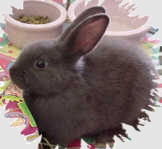
Medical Concerns for Pet Rabbits
by Sandi Ackerman
Red Urine
Rabbits' urine varies in color from clear to yellow to brown to bright red. This is usually not a cause for alarm unless there are additional signs such as sitting and straining to urinate, loss of appetite or temperature. When you see red urine, don't panic. Just keep your eyes open for other signs that might indicate a problem. If in doubt, you can have your veterinarian test to see whether there is blood in the urine.
Amoxicillin Danger
Never let a veterinarian give your rabbit amoxicillin. It is a pink liquid antibiotic that smells like bubble gum. Amoxicillin is very dangerous for rabbits, and has killed many more than it has helped. Any penicillin-based drug can be dangerous for your rabbit, so try to find a veterinarian who is knowledgeable about rabbit-safe antibiotics, and who is familiar with the safer drugs such as Chloramphenicol, Tetracycline, sulfa-drugs based like Septra or TMS, or enrofloxins such as Baytril or Cipro.
Cedar and Pine Shavings
These are very bad for your rabbit and other pets. The aromatic hydrocarbons produced from softwood bedding can cause both respiratory and liver damage in rabbits and other small animals. Use organic litter in the litter box and put newspaper in the cage tray.
Spay/Neuter
The House Rabbit Society has had over 1000 rabbits spayed or neutered with approximately 0.1% mortality due to anesthesia. On the other hand, the risk of reproductive cancer (which is fatal) for an unspayed female rabbit stands at approximately 85%, which makes spaying a necessity. For male rabbits, the benefits are primarily behavioral (eliminating spraying and hormone-related aggression), but are just as important. A knowledgeable rabbit veterinarian can spay or neuter your rabbit with very little risk to a healthy rabbit.
Teeth
Rabbits' teeth can be misaligned. This condition is known as malocclusion, which means that a rabbit's constantly-growing teeth are not wearing down properly. If the misalignment is bad, the teeth will need to be clipped periodically so that the rabbit can eat. Your veterinarian can do this for you, or can show you how to do it at home. Usually malocclusion just strikes the front teeth, but occasionally, the back teeth can also be misaligned. One indication of this is a wet chin that is caused by drooling. If this is the case, your rabbit will need his molars trimmed by a veterinarian on a regular basis.
Hairballs
Rabbits shed their hair every three months. Every second shedding is light, followed three months later by a heavy shedding. This is an important factor in rabbit deaths. You need to brush and comb your rabbit to get the hair off of them when they start to shed. Rabbits groom themselves like cats and will ingest all of the loose hair, which they cannot vomit as can cats. For this reason, besides regular grooming, they must have constant access to fresh hay every day, as the fiber helps the hair pass through the digestive system. You can also give your rabbit cat hairball preparations such as Petromalt or Laxatone once a week when not shedding and daily during their molt. Finally, daily exercise is another important factor in the prevention of hairballs.
Surgeries
Make sure your rabbit is in good health prior to elective surgeries. Food and water should not be removed from a rabbit the evening before surgery! Any change in diet can upset a rabbit's sensitive digestive tract and cause problems in post- operative recovery. One of the reasons some veterinarians recommend removing animals' food before surgery is the possibility that they may vomit. Rabbits cannot throw up, thus this is not a concern. Additionally, some veterinarians are concerned about spaying rabbits with a full cecum. Unfortunately, the cecum would take 3-4 days of fasting to empty out, and by that time, the rabbit would be dead. So please, do not fast your rabbit before surgery! After surgery, make sure the rabbit's cage is clean, and check her incision site daily for swelling or discharge. Do everything you can to get your rabbit to eat again as soon as possible after returning home. To coax him to eat again, you may have to offer a variety of treats, including his regular pellets and hay. If your rabbit has not eaten for 48 hours after surgery, consult your veterinarian.
Bacterial Infections
The first indication of an infection may be a runny nose or eye, sometimes a high temperature, sometimes a rattling sound from the lungs or (rarely) a coughing sound. It is important to see your veterinarian as soon as the first symptoms of any infection appear, as they are more easily cured when caught in the early stages. The bacteria you may hear the most about is called Pasteurella. This used to be a major problem, but with the newer antibiotics, this bacteria can often be eliminated. And, if not totally eliminated, it can be controlled with the use of long term antibiotics. Most of the symptoms described are quite common for many types of bacteria, so it is important to have your veterinarian do a culture to determine exactly what is being treated.
Digestive Problems
The following symptoms require that you see your veterinarian immediately. Diarrhea-as in human children, diarrhea in rabbits can be fatal. Rabbits have various kinds of diarrhea, if it's runny, messy and smelly it's easy to identify. A more subtle form of diarrhea (which does not require the urgency of runny diarrhea) is when the droppings appear to be normal, but "squash" when you touch or sweep them up. You may also see "clumpy" diarrhea. This will be the consistency of silly putty, with normal round droppings mixed in. Diarrhea usually requires antibiotics from your veterinarian. Other signs to watch for are loud tummy growling, small and/or misshapen droppings or no droppings at all. See your veterinarian if any of these symptoms appear. (Veterinarians often misdiagnose this problem as being a hairball.)

